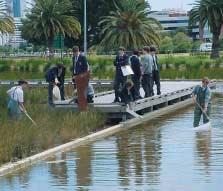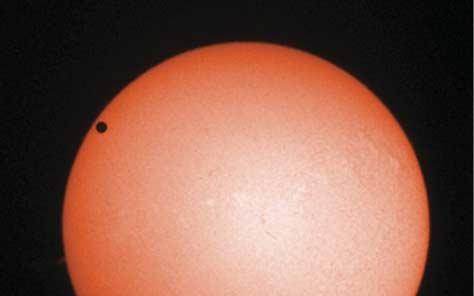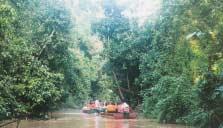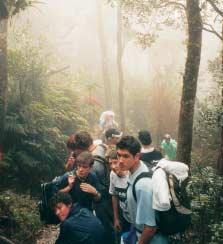
9 minute read
Science
In the science learning area we have always known that Ray Priskich, Head of Science, is a leader secondto-none. He is very modest about his achievements but it came as no surprise to us all that he was awarded the Inaugural Premier's Prize for Secondary Science Teaching - for excellence, innovation, use of technology and curriculum development. The highly prestigious award was presented by the premier, Dr Geoff Gallop last November. Congratulations Ray - you certainly earned it. This has been a typically busy year in the science department particularly where the staff has consolidated its grasp of Curriculum Framework in Year 8 and 9. The extension of the new system into Year 10 and then upper school over the next few years is presenting a significant challenge. For some time it has been evident that a small number of students who find science very challenging would benefit from a smaller class size and a lower student/teacher ratio. In Term Three fourteen very lucky students were selected to form a small focus class under Mr Mike Slack-Smiths' watchful eye. He excels in his ability to engage and enthuse such students and his warm, personal approach enables these students to stay in touch with the discipline of science. It is proving to be very successful and will be extended progressively into Years 9 and 10. The TEE results of 2003 were, again, excellent with all four subjects achieving above the state average thanks to the hard work and dedication of the upper school staff of Mr Al Hay and Mr Jim Shackleton in Chemistry, Mr Ray Priskich and Mr Ed Clark in Physics and Mr Tim Blake in Biology and Human Biology. We hope to achieve similar results this year, particularly in Human Biology with the enthusiasm and academic rigour that Mrs Brigitte Savy-Walsh has brought to the Year 12 group. In Term Two and Three Ray Priskich took a well deserved long service leave and was replaced by Mr David Adeline who has maintained the high standards in physics. A number of new excursions were made this year. Mr Bobby Emmanuel, extending the scope of the new aquaculture topic in Year 10 Science, took all four classes to AQUA for a great day out. Trinity was invited to take part in the monitoring of the newly opened Point Fraser Wetland on the banks of the Swan River close to the Hyatt. The Year 11 Biology students make regular trips to complete a macroinvertebrate survey. The results are sent to Synrix - the designers of the wetland for analysis. The Biology program continues to extend the classroom boundaries
with other trips to the Hills Forest Discovery Centre, Star Swamp, Perth Zoo, various locations in the Perth Metro area and the pinnacle of the Year 11 course –the three day South West Excursion. We visited Dryandra, observing and trapping endangered animals and the Stirling Ranges looking at endemic plants as the students climbed Bluff Knoll. Our Year 9s visited the Geology museum at UWA as part of the Earth Science topic. This year the Sabah Expedition invited Aquinas College to participate and twenty one Mr Ray Priskich Head of Science students and three staff had a wonderful experience. The annual series of competitions took place with students entering the National Chemistry Quiz and The Rio Tinto Science Challenge. Students have applied for the Murdoch University Science and Engineering Camp and the Siemens Science Experience – all of which are excellent experiences. The outcomes approach to learning in the middle school and our new laboratories has necessitated a cultural change. Our laboratory technicians Mr Lim and Ms Debra Renfrew have, once again, done a fantastic job with their elaborate juggling of resources and the expansion of our resource base ensuring the smooth transition. Their efforts have ensured we can strive for quality learning in science and be better able to assess the appropriate level at which each student operates. In my capacity as Acting Head of Science I have been able to observe the enthusiasm, professionalism and dedication of the science staff to the wellbeing of their students. I would like to thank them for doing a great job and also thank them for all the support they have given me personally over the last two terms.
Mr Tim Blake
Acting Head of Science
Academic
Academic
Trinity College Observatory
The astronomical events of 2004 were dominated by two rare events of interest to all budding astronomers. On June 8th for the first time since December 6th 1882, we were privileged to witness the transit of the planet Venus across the face of the Sun. The Trinity College Observatory was able to capture this event in the late afternoon using a dedicated solar telescope that allows us to observe the Sun safely. The telescope allows a view of the Sun in a very narrow part of the spectrum known as hydrogen-alpha. The accompanying image shows Venus shortly after the ingress of the planet on the surface of the Sun. The other highlight of the year was the appearance of two bright comets, C/2001 Q4 (NEAT) and C/2002 T7 (LINEAR) which reached naked-eye visibility. This was the first time in over a hundred years that two comets reached this level of brightness in our skies at the same time. The College Observatory has undergone several improvements over the year, including substantial upgrades to the computer hardware and software. We have also installed a remote control system that allows us to operate the entire observatory remotely via an internet connection. Many of the students’ images have been obtained via this remote control facility without anyone being in attendance at the observatory dome! A further improvement has been the addition of a narrow-band Hydrogen-alpha filter to the 12.5 inch
Mr Jeremy Dixon Ritchey-Chrétien telescope. This filter enables us toObservatory Manager study emission nebulae in remarkable detail. A highlight of our year was the annual Western Australian AstroFest which was hosted in the College grounds and provided a ‘hands-on’ experience of astronomy for hundreds of visitors. Many took the opportunity to climb the stairs and have a look at some magical sights through the telescopes in our dome. As usual, the proceeds of the AstroFest were donated to the Starlight Foundation. We are looking forward to an event filled calendar in 2005 and we are hoping for ‘clear skies’.
Jeremy Dixon
Observatory Manager

Sabah Malaysia Expedition
The headman of Dagat summed it up nicely "We are Doves and Ducks" - we are the same as we have feathers but we can not communicate. Dagat is a tiny fishing village on the banks of the Tabin River three hours by 4WD vehicle and one and a half hours by boat from Lahad Datu in N.E Borneo. Twenty four of us had arrived at the village enroute to the SOS Rhino field camp in the 120,000 hectare Tabin Reserve where we hoped to look for Sumatran Rhinos. The whole village participated to cook up a feast for our visit and with much arm waving, smiling, hand shaking and impromptu halftranslated speeches we think the 'ducks' suitably thanked the 'doves' for their boundless hospitality. During the July holiday a group Biology, Human Biology and Geography students from Trinity and Aquinas travelled to Sabah in Borneo to explore tropical rainforests and other habitats. An introduction to mangrove swamps started the activities. At low tide thousands of mud-crabs and molluscs compete for the debris brought in with the tide. The next day our journey took us to Poring Hot Spring, where we were able to learn much about both the top and the bottom layers of Diptocarp rainforests on the exhilarating 30m high canopy walk. Afterwards our shaking legs received a much welcome bath in the scalding volcanic springs that give the area its name. An arduous two day hike to the top of Mount Kinabalu at 4095.2m followed. The incredible variety of orchids, epiphytes, ferns and mosses that adorned the tropical rainforest along the trail was quite amazing. As we climbed further up the mountain the vegetation changed to stunted cloud forests full of flowering rhododendrons and hanging moss just visible in the ever-present mist. After a 3000m climb the chalets were a welcome relief. At 2.00am the more fit (and perhaps more foolhardy) awoke and scrambled through the darkness fighting painful muscles and the increasing affects of altitude to be rewarded with a quite magnificent view over the South China Sea at dawn. The trip continued to Sepilok visiting the Orangutan Rehabilitation Centre for orphaned Orangutans. These sanctuaries are the only hope for these gentle creatures whose habitat is being continuously destroyed. A side-trip to the war memorial at Sandakan, where several thousand allied soldiers died in the Second World War, proved to be a very moving experience. The highlight of the trip was at Sukau, on the banks of the Kinabatangan River. A small resort, carved out of the surrounding rainforest, served as a base for boat trips to see a multitude of primates, reptiles, birds and plants. A particularly close encounter with wild elephants rounded off a memorable two days. The amazing Proboscis Monkeys abound in this area and were easily seen foraging in the mangroves along the river. They were accompanied by Silver Leaf Monkeys, Pig-Tailed Macaques and Long Tailed Macaques all squabbling for the best food. An hour offshore from Sandakan is Turtle Island. Here Green Turtles and Hawksbill Turtles come ashore to lay eggs in the sand. After a relaxing day in the sun we were fortunate to witness first-time females lay eggs late at night. The final two days were unforgettable when we joined SOS Rhino, a non-profit organisation dedicated to saving rhinos worldwide, looking for the critically endangered Sumatran Rhino. Only thirty of these shy creatures exist in the whole of Borneo and we were extremely fortunate to see the tracks of a young animal during a gruelling four hours survey through thick rainforest. The only way to get to Dagat and the field camp was in tiny boats along long winding rivers surrounded by lush Diptocarp forest. The field camp was a small area simply carved out of the forest. The camp itself was made from branches tied together with vines we half expected Tarzan to come to visit. The survey was very hard work literally cutting thorough the thick undergrowth all the time checking for rhino tracks. We discovered several mud soaks where animals bathe and found many tracks of elephant, pig, deer and banteng (wild cattle) but only a single set of rhino tracks. I am sure the boys will not forget their meal of fish caught in the river and ferns from the forest. The expedition was a wonderful opportunity for the boys and it is hoped it will remain a permanent fixture in the Trinity calendar.
Tim Blake












